In September 1915, just over 100 years ago, the newly built Knockaloe railway line was brought into use in order to provide transportation of goods to and from the Knockaloe WW1 Internment Camp. The 1 mile and 6 chains long Knockaloe railway line was funded by the British Government and was in use from September 1915 for 5 years and fully dismantled within 10 years. At its peak it was making an average of 18 round trips per day.
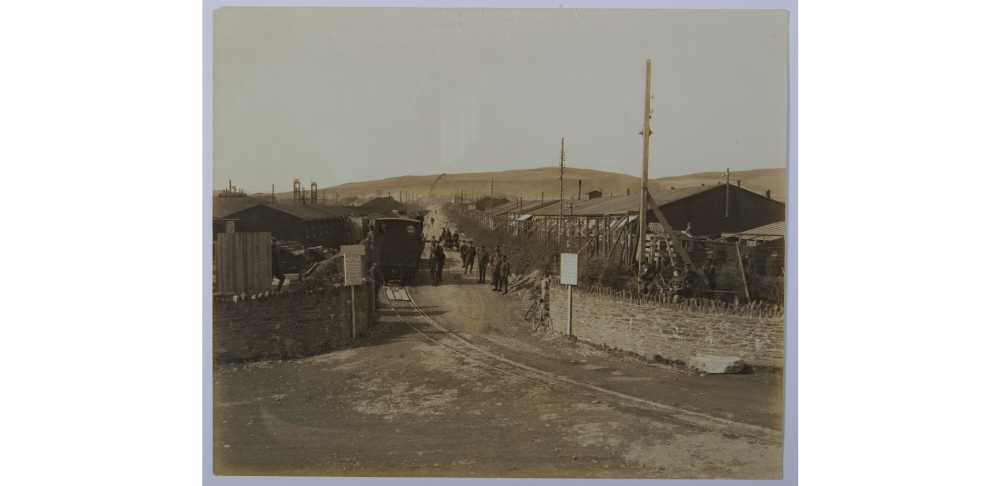
Figure 1 The No 15, Caledonia, at the entrance to Knockaloe Camp (Image Courtesy of MNH PG/5291/9a). This shows how the line runs right up the main driveway through the Camp beyond the train. The picture also shows the notice boards at the entrance to the camp forbidding access to the public and warning them not to loiter near the camp.
The Knockaloe railway line extended from Peel’s main train station directly into Knockaloe Camp. It also involved a tramway style track extension onto Peel East Quay, as explained by newspaper Mona’s Herald on 8 August 1915:
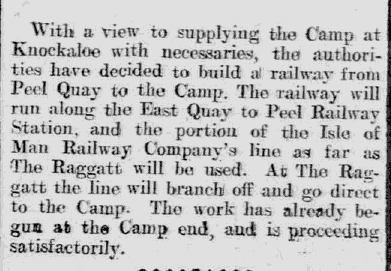
Figure 2 Mona’s Herald 8 August 1915 courtesy of MNH
This new line allowed the vast quantities of goods required to feed, clothe and house over 24,000 internees and their guards to be transferred directly from boats moored at Peel, onto the train for transportation to Knockaloe Camp.
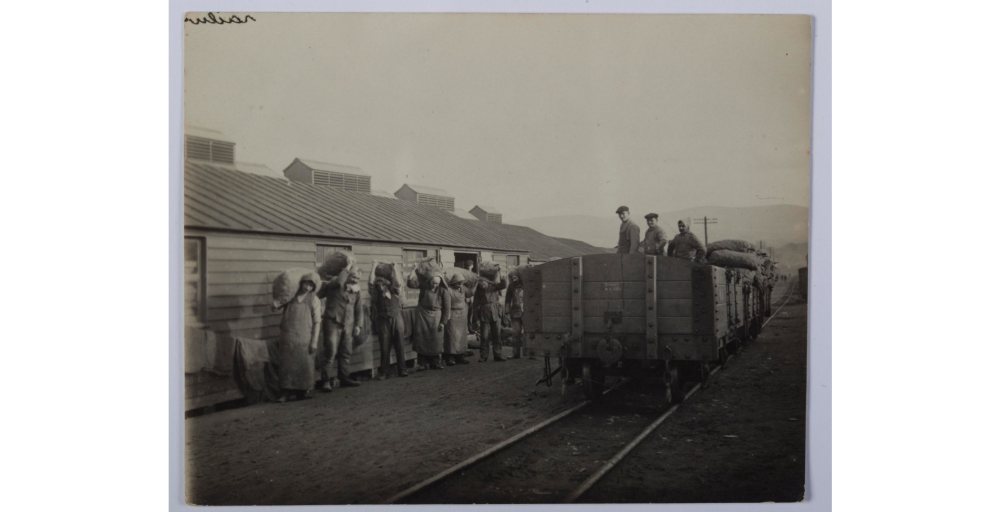
Figure 3 Internees unloading (probably coal) from the wagons at Knockaloe (Image courtesy of MNH PG/5290-10a)
The Knockaloe train line branched off from the main Peel to Douglas line above the Raggatt, where a wooden bridge carried it across the Neb River. John Boyd notes "On the curve between the junction and the Neb bridge, there was a passing loop. Here the engine would run to the rear of the train which it propelled up the bank for safety reasons and easier shunting into the sidings. The Caledonia always worked chimney first up inclines such as the Knockaloe branch to ensure that the was plenty of water covering the boiler, this was common practice for the use of engines on steeper gradients. The track then ran alongside the road to Patrick Village, where there was "a long siding alongside the Patrick Road to the left of the ascending trains, entered by a facing siding, serving the laundry" before curving off to the right to start to align itself to cross the road, with another loop and a goods shed on this curve. It then crossed the road immediately beside Patrick Churchyard and schoolrooms into Knockaloe Camp, following the main driveway right up through the middle of the Camp. “Once within the camp it passed the guardroom and Construction office. Climbing up the main Camp Road there was a facing siding on the left serving the Quartermaster’s stores. A short loop, then a long loop followed, serving Hospital, further Guard Room, Catering Store and Bakery. Two sidings marked the terminus within the Administration Block, these served the Power House to which coal was brought, Anthracite Store, Canteen Store, etc.”
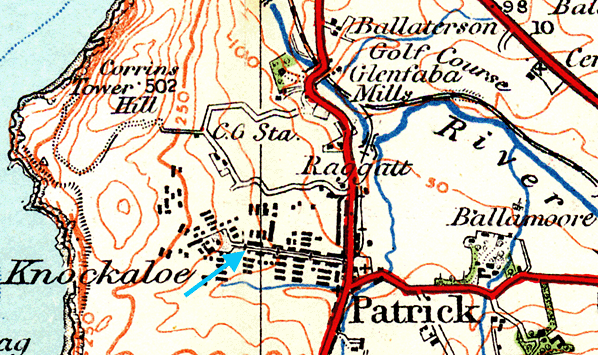
Figure 4 Excerpt from the 1924 Ordnance survey map showing the train line running through the entire camp access road, terminating almost at Knoackaloe Moar Farm, the end of line denoted by the blue arrow (extracted from http://www.disused-stations.org.uk/k/knockaloe/index.shtml by Nick Catford)
With its 1 in 20 incline, this new line was the most steeply graded of any non-electric line on the Island, and so it required a suitable engine which could handle such a gradient, the Caledonia.
The Caledonia was built in 1885 (works No 2178), and was originally specifically purchased by the Manx Northern Railway to tackle the far more steeply graded Foxdale Railway line, part of which had a 1 in 12 incline.
She was unique to the Isle of Man fleet in that she had the 0-6-0T wheel arrangement, as opposed to the 2-4-0T wheel arrangement of the other Isle of Man engines, and was the only Isle of Man engine built by Dübs & Company, of Glasgow, the remainder being manufactured by Beyer Peacock of Manchester. Most importantly, she was larger than any other engine on the Isle of Man, with a tractive effect of more than twice that of the other engines. This meant that, of all of the Isle of Man engines, she has had the most varied career.
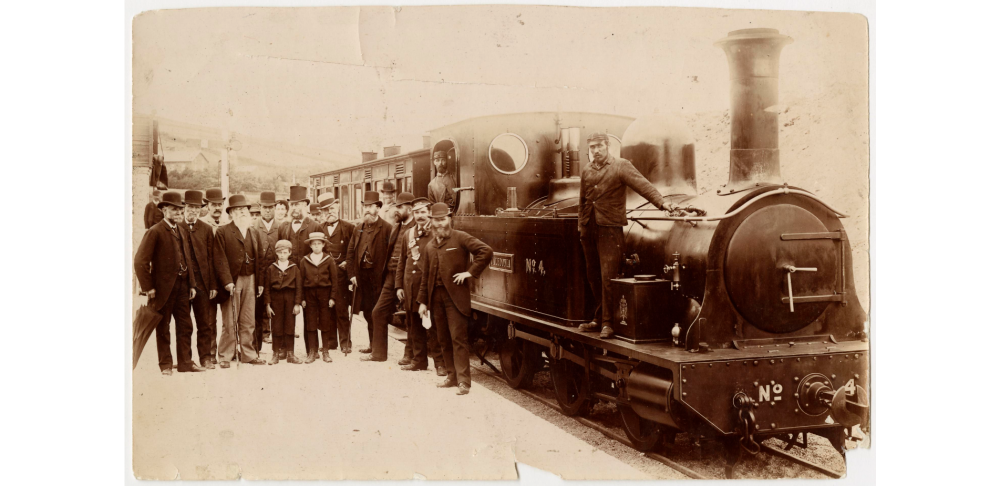
Figure 5 Caledonia at the inaugaural journey of the Foxdale line, showing the lack of platform at the Foxdale terminus. Courtesy of MNH PG14216
Her special qualities meant that the Caledonia was hired for the construction of the 1 in 12 Snaefell mountain railway. She was shipped from Ramsey to Laxey and was taken through the streets on baulks and rollers and an additional rail was laid for temporary use to allow her to push the loaded ballast waggons. The 4.9 mile railway which climbs the 2,036 feet of the Island’s only mountain was completed in an incredible 7 months.
After the Isle of Man railway merger in 1905 she was renumbered 15 in the Isle of Man Railway fleet (having previously been Manx Northern's No. 4), and with the closure of the Foxdale Mines, in 1911, was only used occasionally for heavy freight movements, such as the Ramsey Cattle Mart specials and for snow clearing, having a snow plough fitted to her for the purpose. Her strength made her perfect for the Knockaloe Railway.
Indeed the very weight of her which facilitated taking the heavy loads uphill to Knockaloe also meant that controlling her downhill was perhaps the greatest challenge. The newspaper Mona’s Herald reported the launch of the Railway on 8 September 1915, and highlighted the (misspelled) Caledonia’s past, and indeed her mishaps:
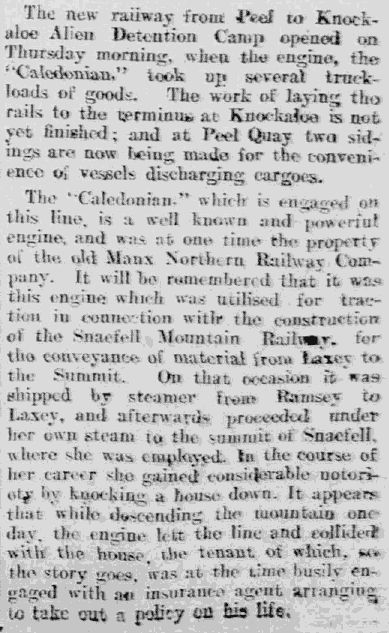
Figure 5 Courtesy of MNH
Doubtless many of the internees would have noted the Caledonia’s manufacturer’s plate on the side of the engine as she arrived at the camp and registered the irony of their Camp’s train being manufactured by a company founded by an “alien”. Henry Dübs (1816 – 1876) had been born Heinrich Dübs in Guntersblum, near Darmstadt, Germany. Dübs was an engineer and former employee of Beyer Peacock, before founding Glasgow based Dübs and Company, at one time the second largest locomotive manufacturer in Britain.
The Knockaloe train line alleviated what had become a logistical nightmare for the authorities. Tom Heavyside notes that the Knockaloe Line’s peak year for traffic was reported as in 1916 when 6,800 wagons were delivered to the camp. This is an average of 18 trips per day!
The line operated until October 1920, one year after the last of the internees left the Camp. For the final year, Caledonia assisted in the dismantlement of the camp. The Irish rails as they were known and sleepers had been purchased from Great Northern Railway (I) Ireland by the Biritish Government for use of the Knockaloe railway. They were already worn having been of 1882 vintage. After the camp railway was lifted in 1923/24 they were bought by the Isle of Man Railway Company for future use on the Port Erin line between Ballahick and Castletown. They were in place until 2002 when the sewage pipe was laid from Port Erin to Meary Veg. The only remaining evidence of the existence of the Knockaloe branch line at the Camp is the Engine Shed.
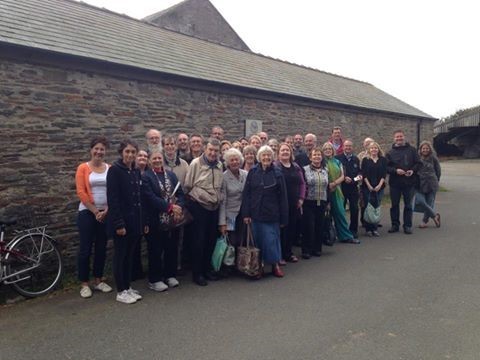
Figure 6 Charity Board members with internee descendants, members of the Anglo-German family history Society, internment academics and members of MNH in front of the Engine Shed on Knockaloe in August 2014, which now bears a plaque commemorating the Internment camp site, as donated by the Anglo German Family History Society
The Isle of Man Steam Railway Supporters Association website, the books of J L Boyd, and the Isle of Man newspapers tell her story:
1920 - 1966 |
The Caledonia continued to be used for occasional heavy freight movement, including playing a role in the second world war carrying the thousands of tons of rubble from Foxdale tips to build aerodrome runways. She was also used for snow clearing, such as the "big snow" of 1940.
|
1967-1975 |
When the Marquess of Ailsa took over Isle of Man Railway operations in 1967, Caledonia was repainted into spring green livery and saw service once again, owing to a locomotive shortage, breaking through the reopening day ribbon. She was repainted again into something akin to original Manx Northern livery at the expense of the Isle of Man Steam Railway Supporters' Association and hauled a special train for them to St. John's in 1968 by which time she was steaming poorly. This was the locomotive's final period in service. |
1975-1993 |
She was placed in the, then new, museum at Port Erin |
1993–1999 |
The Caledonia was returned to Douglas by road for steam feasibility tests and by 1995 she was completely overhauled and was the star of the show, operating on the 1 in 12 gradients of the Snaefell Mountain Railway as part of the centenary celebrations, marking her return to the Mountain Railway following her work in assisting to construct it 100 years previously. Her return to service also saw a repaint into the original livery including much intricate lining out and lettering on the tank sides. The new tanks, complete with dummy rivets to give authentic appearance, were funded by the Isle of Man Steam Railway Supporters' Association and a diamond plaque was fitted to the interior of the rear cab sheet to denote this. She then became part of the stable of serviceable locomotives |
1999-2007 |
Whilst the other Isle of Man locomotives were repainted the Isle of Man Railway’s Indian red, the Caledonia was painted dark blue in 1999 and starred as “Thomas” in the annual Thomas the Tank Engine weekend. The Isle of Man Railway is cited as the main inspiration for Reverend Awdry’s “Thomas the Tank Engine” and friends books, set on the “Island of Sodor”, and this annual weekend became a highlight for children.
|
2007-2009 |
The Caledonia reverted to her intricate original paint scheme in 2007 as No 4 in Manx Northern livery and has performed on high days and holidays since this time, leaving the day-to-day operation of the line to the Beyer Peacock locomotives.
|
2009-2013 |
She was withdrawn from traffic for a major overhaul, believed to have been the most significant work carried out since delivery in 1885. The major works were completed in early 2013 when the locomotive returned to traffic following successful test runs.” This fascinating video by Visit Isle of Man shows this restoration of Caledonia and in her full glory following its completion https://www.youtube.com/watch?v=xhHH41z-bq0 |
2014-2018 |
Caledonia was last in service in 2014 and is currently stripped and undergpoing boiler work. The Public Transport Division of the Department of Infastructure advises that she is next likely to see service in summer 2018. |